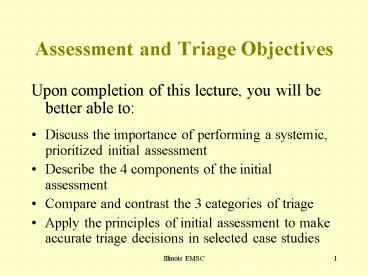Assessment and Triage Objectives - PowerPoint PPT Presentation
1 / 28
Title:
Assessment and Triage Objectives
Description:
... of initial assessment to make accurate triage decisions in selected case studies ... Example Gun Shot Wound to the Chest. Illinois EMSC. 18. URGENT ... – PowerPoint PPT presentation
Number of Views:214
Avg rating:3.0/5.0
Title: Assessment and Triage Objectives
1
Assessment and Triage Objectives
- Upon completion of this lecture, you will be
better able to - Discuss the importance of performing a systemic,
prioritized initial assessment - Describe the 4 components of the initial
assessment - Compare and contrast the 3 categories of triage
- Apply the principles of initial assessment to
make accurate triage decisions in selected case
studies
2
ASSESSMENT AND TRIAGE
3
Considerations in Initial Assessment
- History and physical assessment can be
simultaneous - NOTE The assessment process is stopped to
initiate life-saving measures (CPR) - Cultural and other factors may affect the
assessment process
4
INITIAL ASSESSMENT
- Scene safety assessment
- Acrossthe-room assessment
- Brief physical assessment
- Brief health history
5
ACROSS-THE-ROOM ASSESSMENT
- General appearance
- Airway status
- Work of breathing
- Circulatory status
- Disability (neurological) status
6
SCENE SAFETY ASSESSMENT
- SELF
- People
- Environment
7
(No Transcript)
8
BRIEF PHYSICAL ASSESSMENT
- Airway
- Breathing
- Circulation
- Disability
- Expose/examine
- Fahrenheit
- Get vital signs
- Head-to-toe assessment
- Isolate
9
BRIEF HEALTH HISTORY
- Chief complaint
- Immunizations/isolation
- Allergies
- Medications
- Past health history
- Events surrounding the current problem
- Diet
- Symptoms associated with the current problem
10
BRIEF HEALTH HISTORY
- SAMPLE
- SYMPTOMS
- ALLERGIES
- MEDICATIONS
- PAST HISTORY
- LAST MEAL
- EVENTS LEADING TO
THE ILLNESS OR INJURY
11
INTERVENTIONS
- Interventions are guided by the school nurses
assessment of the students health problem - Interventions are based on the school nurses
guidelines for practice or standing orders.
12
TRIAGE AND TRANSPORT
- Dependent upon the school nurses assessment and
interventions - Dependent on the
IEMP and school
emergency plan
13
TRIAGE
14
TRIAGE CONSIDERATIONS
- Establish triage guidelines
- Initial triage category can be upgraded or
downgraded depending on student response - Gut reaction or sixth sense should be trusted
- Overtriage is acceptable
- Designate experienced RNs for triage
- Reassessment is necessary and essential
- Maintain emergency skills/knowledge
- Triage also used in multicasualty situations
15
TRIAGE CATEGORIES
- EMERGENT
- URGENT
- NON-URGENT
16
EMERGENT
- CONDITION IS LIFE-THREATENING
- CARE MUST BE INITIATED IMMEDIATELY
17
EMERGENTExample Gun Shot Wound to the Chest
18
URGENT
- Condition is severe but not
life-threatening. It requires medical
intervention within two hours but not immediate
care.
19
URGENT
Dog bite to the ear
Wrist fracture without neurovascular compromise
20
NON-URGENT
- Condition is non-acute or minor
- Care can be delayed for hours
21
NON-URGENT Example Minor cut to the lower lip
22
TRIAGE PROCESS
- Initial assessment
- Triage decision
- Plan of care
- Intervention
- Evaluation
- Outcome/disposition
23
TRIAGE AND TRANSPORT
- EMERGENT - Status asthmaticus or worsening
respiratory distress - URGENT - No improvement with treatment
- NON-URGENT - Improvement with treatment and
absence of respiratory distress
24
OUTCOME/DISPOSITION
- Return to class
- Observe in health office
- Transport to home, physicians office or ED with
a reliable parent/guardian - Transport to ED by air or EMS
25
EVALUATION AND FOLLOW-UP
- School health record
- Hospital/primary care provider
- Prehospital personnel
26
PREVENTION
- Recognize and report dangerous areas in the
school - Maintain current health records
- Teach others how to recognize communicable
diseases - Collect and monitor data related to injury and
illness - Share critical IEMP information with faculty and
aides
27
Summary
- One of your primary responsibilities as a school
nurse is to recognize severe illness or injury
among students, using a systematic, consistent
assessment approach. Appropriate triaging is
based on this assessment and guided by triage
protocols and policies.
28
ANY QUESTIONS??





























